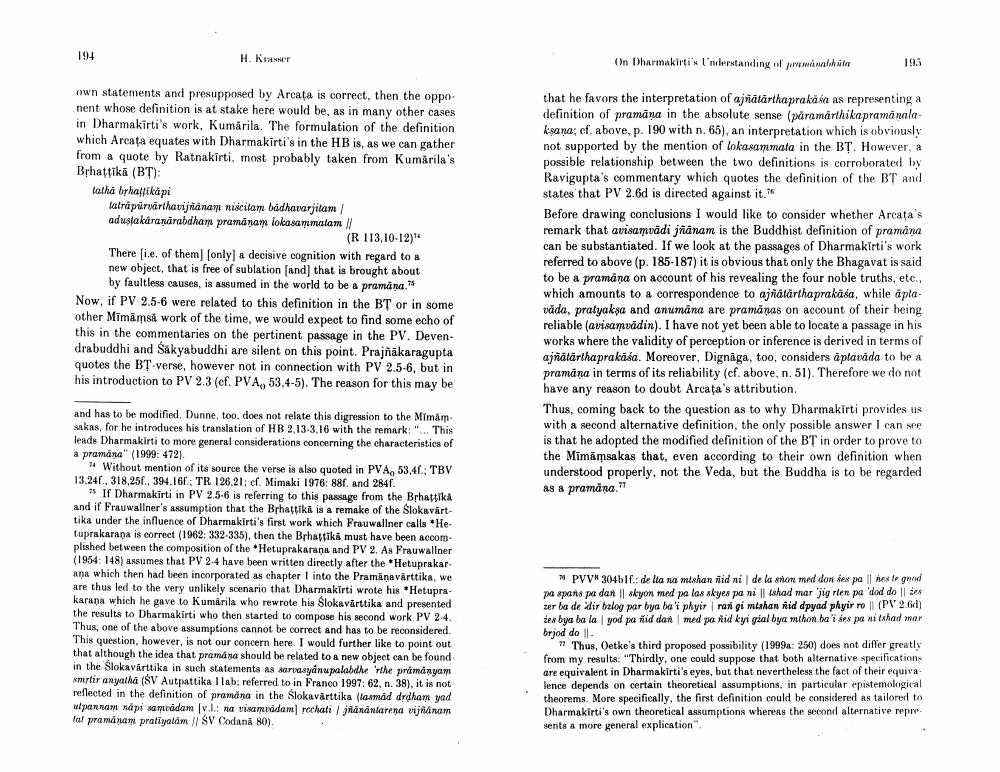________________
194
H. Krasser
On Dharmakirti l'nverstanding of priminalhin
own statements and presupposed by Arcata is correct, then the oppo. nent whose definition is at stake here would be, as in many other cases in Dharmakirti's work, Kumarila. The formulation of the definition which Arcata equates with Dharmakirti's in the HB is, as we can gather from a quote by Ratnakirti, most probably taken from Kumarila's Brhattika (BT): tatha brhalfikapi
latripúrvarthavijnanam niscitam badhavarjitam adustakaranarabdham pramanan lokasammalam
(R 113,10-12) There i.e. of them) (only) a decisive cognition with regard to A new object, that is free of sublation (and) that is brought about
by faultless causes, is assumed in the world to be a pramana." Now, if PV 2.5-6 were related to this definition in the BT or in some other Mimamsa work of the time, we would expect to find some echo of this in the commentaries on the pertinent passage in the PV. Devendrabuddhi and Säkyabuddhi are silent on this point. Prajnakaragupta quotes the BT-verse, however not in connection with PV 2.5-6, but in his introduction to PV 2.3 (cf. PVA, 53,4-5). The reason for this may be
that he favors the interpretation of ajratarthaprakása as representing a definition of pramana in the absolute sense (paramarthikapramanalakaana; cf. above, p. 190 with n. 65), an interpretation which is obviously not supported by the mention of lokasamata in the BT. However, a possible relationship between the two definitions is corroborated by Ravigupta's commentary which quotes the definition of the BT and states that PV 2.6d is directed against it." Before drawing conclusions I would like to consider whether Arcata's remark that avisarvadi jfianam is the Buddhist definition of pramana can be substantiated. If we look at the passages of Dharmakirti's work referred to above (p. 185-187) it is obvious that only the Bhagavat is said to be a promana on account of his revealing the four noble truths, etc., which amounts to a correspondence to ajralarthaprakása, while aplaudda, pratyaksa and anumana are pramanas on account of their being reliable (avisamvadin). I have not yet been able to locate a passage in his works where the validity of perception or inference is derived in terms of ajratarthaprakāka. Moreover, Dignāga, too, considers a plavida to be a pramana in terms of its reliability (cf. above, n. 51). Therefore we do not have any reason to doubt Arcata's attribution. Thus, coming back to the question as to why Dharmakirti provides us with a second alternative definition, the only possible answer I can se is that he adopted the modified definition of the BT in order to prove to the Mimamsakas that, even according to their own definition when understood properly, not the Veda, but the Buddha is to be regarded as a pramana."
and has to be modified. Dunne, too, does not relate this digression to the Mimam. sakas, for he introduces his translation of HB 2.13-3.16 with the remark: "... This leads Dharmakirti to more general considerations concerning the characteristics of a pramana" (1999: 472).
# Without mention of its source the verse is also quoted in PVA, 53,47., TBV 13.24f., 318,25f., 394.161.: TR 126.21; cf. Mimaki 1976: 88f, and 284f.
" If Dharmakirti in PV 2,5-6 is referring to this passage from the Brhatika and if Frauwallner's assumption that the Brhattika is a remake of the Slokavårt. tika under the influence of Dharmakirti's first work which Frauwallner calls Hetuprakarana is correct (1962: 332-335), then the Brhatika must have been accomplished between the composition of the Hetuprakarana and PV 2. As Frauwallner (1954: 148) assumes that PV 2-4 have been written directly after the Hetuprakar. ana which then had been incorporated as chapter into the Pramanavårttika, we are thus led to the very unlikely scenario that Dharmakirti wrote his Hetupra karana which he gave to Kumarila who rewrote his Slokavirttika and presented the results to Dharmakirti who then started to compose his second work PV 24. Thus, one of the above assumptions cannot be correct and has to be reconsidered This question, however, is not our concern here. I would further like to point out that although the idea that promia should be related to a new object can be found in the Slokavirttika in such statements as sorosan palabdhe the pramanyam mpiranyatha (SV Autpattika Ilab, referred to in Franco 1997: 62, n. 38), it is not reflected in the definition of pramana in the Slokavårttika (lasmad drdham yod wipannam nápi samvadam vili na visamvadam rechali jrlanantarena vijnanam lal pramanam pratiyalam SV Codaná 80).
NPVVK 304b1f.: delta na mishan vid ni de la shon med don des palmes legnad papan dan | skyon med pa las skyen pani || Ishad mar jig rien pa Wod do sex ser la de dir blog par byabo'phyir rangi mlahan Rid dpyad phyir rol (PV 2.6) żes by ba la yod pa riid dan med pa lid kyi gial bya mthon bar ses pa silahad mer brjod doll
Thus, Oetke's third proposed possibility (1999a: 250) does not differ greatly from my results: "Thirdly, one could suppose that both alternative specifications are equivalent in Dharmakirti's eyes, but that nevertheless the fact of their equiva lence depends on certain theoretical assumptions, in particular epistemological theorems. More specifically, the first definition could be considered as tailored to Dharmakirti's own theoretical assumptions where the second alternative repre sents a more general explication".




